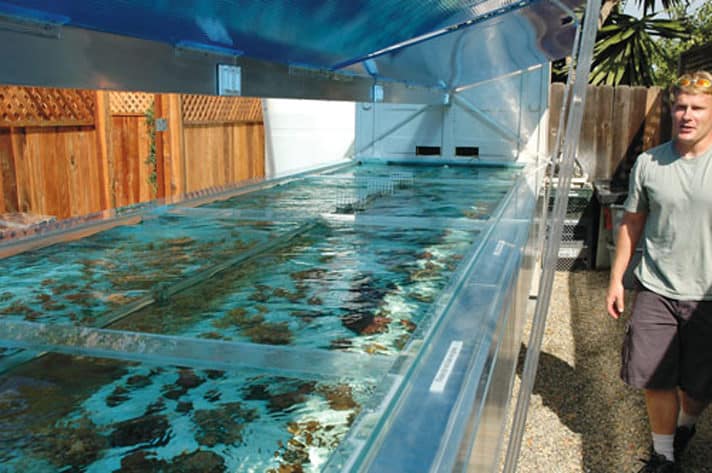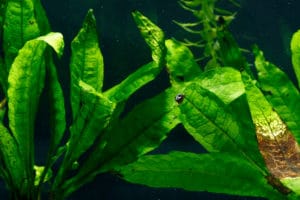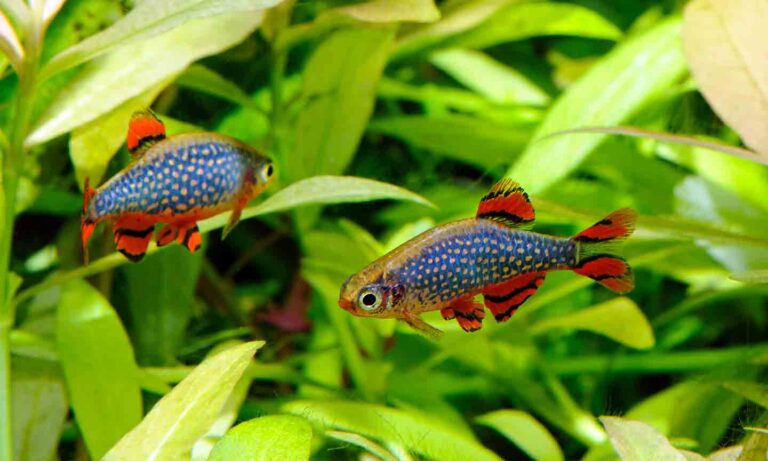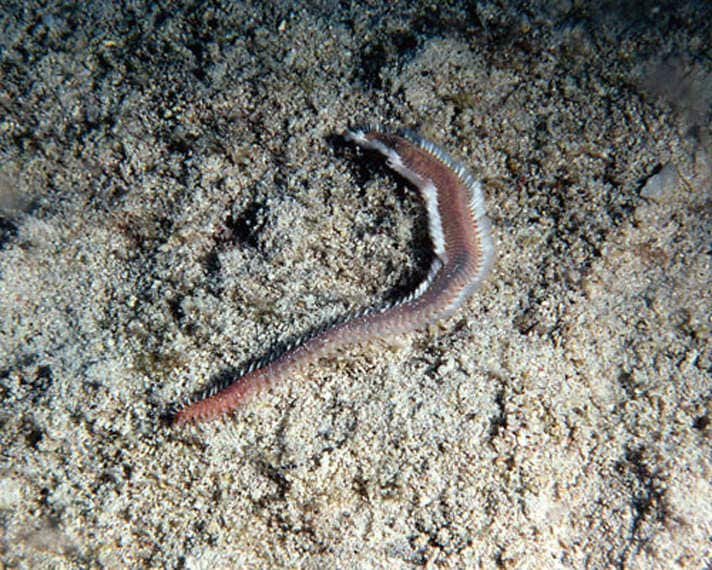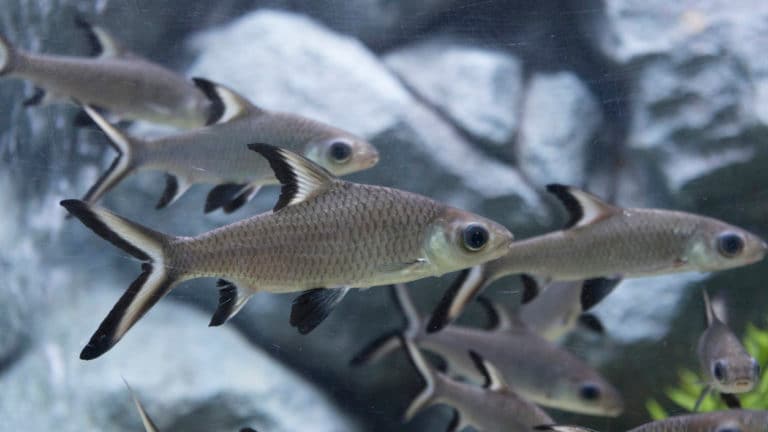Every reef aquarist has dreamt about it, but few do it. We see the beautiful, glittering corals in our tanks, and we think to ourselves: “I can make a killing propagating these things. All I need is my own custom coral propagation setup.”
While few ever try their hand at coral farming, one Southern California hobbyist by the name of Steve Garrett has actually done it. Garrett is a hobbyist with an engineering background who started his custom-built coral propagation system back in 1997. His system has experienced several major overhauls since then, but the intent is still the same. Like in his original system, he’s primarily propagating small polyp stony (SPS) corals in his redesigned 20-foot-long, 4-foot-wide, 14-inch-deep coral farm.
Dr. Wet Thumb
The original system, which took a year to complete according to Garrett, featured a totally different setup than his current 20-foot-long uber system. Garrett originally kept two main tanks, 4 feet wide by 8 feet long by 2 feet deep with a volume of 450 gallons each, constructed of plywood, fiberglass and epoxy paint.
Garrett wasn’t completely satisfied with the original system: “The old system was connected on the shorter side with a sloping trough. The water started in the first tank, which housed the parent colonies, then it rushed down the trough and across the surface of the second tank, which housed most of the growing frags. The corals were suspended above the deep sandbed and live rock using egg crate and PVC. Two 2-inch stand pipes at the far end of the second tank returned the water to a 200-gallon sump half buried in the ground and located under the first tank.”
While the old system no longer stands (it was replaced entirely by the new system), his description does sound quite impressive in scope. The original 1,100-gallon setup was nothing to sneeze at, especially since it was located outside.
Garrett was not completely happy with this system, as it required a lot of maintenance: “The walls and underside of the main tank were packed with house insulation and skinned with another layer of 1/2-inch plywood. The lids back then were made with blue holiday saran wrap sandwiched between two layers of clear plastic and stapled to a lightweight wood frame and had to be replaced every year,” Garrett said. The lid issue would not be solved until Garrett built the second version of his coral propagation setup.
Learning From Experience
The original design had its share of flaws. Because the sides of the setup were covered in plywood and insulation, the only way to view the corals was through a cup with a flat, clear bottom placed on the surface of the water. One can only imagine the maintenance problems that surfaced under that method of viewing corals. Garrett mentioned that he would often have to use one hand to move corals around or scrape algae out of the system while his other hand was busy holding the cup in place.
“The first two years were filled with mini disasters, infestations and algae outbreaks. I learned a lot with every issue and put in place devices to prevent and avoid future problems,” Garrett said. “Eventually, one of the plywood tanks started to leak. I knew this would happen and had been experimenting with new materials and designs that would eliminate the many problems.”
Coral Farm Overhaul
After his first system’s leak in 1999, Garrett met his wife and the system took a backseat to starting a family. The Garretts had a daughter and spent a delayed honeymoon in the southern islands of Japan.
In 2002, Garrett met Steve Tyree — a coral farmer since 1993, an avid hobbyist and speaker — and showed him his system. Tyree introduced Garrett to the Southern California Marine Aquarium Society (SCMAS — http://www.officialscmas.org/). At the first meeting Garrett attended, he unveiled his selection of coral frags from his first setup, which he thought wouldn’t be too impressive to long-time hobbyists of the SCMAS, but he was surprised by the reception his frags received.
Over the next four years, Garrett worked to expand the variety of SPS corals that he was capable of farming, and he spent time, money and energy reinvesting in his system. Eventually, it became clear that for his system to grow, he would have to completely overhaul its design.
“It came to the point that I would spend the majority of my weekends working on removing algae, searching for coral pests, painting and fixing things. I knew I would have to design a new, less-demanding system or discontinue my outdoor coral farm.”
A New Setup is Born
Garrett’s new setup appears deceptively simple at first glance. With the lids down, it’s easy to mistake it for a peculiar garden shed or oddly shaped greenhouse. But, when Garrett props up the blue cover panels of his setup, it looks like a giant dragonfly about to take flight. This is all made even more impressive when you realize that Garrett does not use supplemental lighting, for the most part, and that his system gets most of its energy from the sun.
Initially, Garrett wanted to use recyclable materials that are well-suited to the outdoor extremes of Southern California. He had a very organic concept for the tank in mind, but he struggled with finding the right materials for his ambitious new setup: “I was focusing on a free-form design that would be built with high-density polyethylene with acrylic viewing windows sealed into the sides. After researching how to heat weld and practicing it, I realized this thing would take years for me to build, would probably develop a leak and would end up costing too much for materials.
“I at first had no desire to use glass because it seemed too delicate and expensive for use outside, and acrylic was not an option because glue joints aged and cracked from the intense sun.”
Designs and Redesigns
After frustration with the high-density polyethylene set in, Garrett reconsidered the direction he was taking his new setup. “I eventually gave the idea of glass a second chance. The design I finally decided to go with wasn’t as organically shaped as I had wanted to build with the plastic.
“In fact, it was quite the opposite; it now resembled something from the Frank Lloyd Wright-era with clean sharp lines. Working with the glass was not too difficult. It took about two to three weeks to build the glass tank, and most of that time was spent waiting for the silicone to dry.”
Over the course of the remodel, which took about six months of work, two days a week, with occasional evening work sessions, Garrett reinvented his design slightly. His first big problem was heating, but he solved this by installing a gas hot water heater with a pump and a large heat exchanger. “Last year, there was an especially cold morning, below 32 degrees Fahrenheit for several hours, but the system maintained a comfortable 74-degree temperature, so I knew the heater worked great.”
This setup offered more heating capacity without the associated dangers and costs of electric heaters. In many other places, Garrett used more durable, robust components to accommodate his redesign. This is a theme often repeated with Garrett’s super-sized coral farm.
“This new design separated the corals from the deep sandbed, live rock and plants. It also allowed for alternating flow, occasional water surges and, best of all, I could observe the corals as you would in a normal reef tank. The delicate equipment like skimmers, pumps and controllers were now located in a shed out of the hot sun and weather,” Garrett said.
Farming Follows Function
Garrett began to stock his system slowly. He started by adding dry base rock, sand and artificial salt. He then seeded these with more base rock and sand that he was reasonably sure had no undesirable hitchhikers. Garrett says he kept his plumbing system simple, while trying to maintain an efficient setup.
Essentially, the system is set up as a big loop. Polyethylene sheds on either end of the main tank house Garrett’s equipment; on one end Garrett keeps a refugium complete with macroalgae and clams, and on the other, Garrett keeps his controllers and oversized Euro-Reef protein skimmer.
The design is very elegant, with water flowing out of the main 650-gallon tank into the refugium, where detritus from the fish in the system feeds a deep sandbed and several clams. From there, the water leaves the refugium and enters a series of chambers directly underneath the main tank.
The first chamber, a 10-foot-long, 300-gallon sump set up with another deep sandbed and live rock, is filled with sponges and filter-feeding animals, helping to further reduce nutrients such as nitrate. After this, the system water enters another 300-gallon sump where additional equipment is located.
After the water leaves the sumps, it enters the shed at the other end of the setup, where a protein skimmer is located and make-up water is added. From there, the water enters the system again from two 11/2-inch mixing eductors, which create all the necessary flow in the tank. The rate and direction of the water flow can be changed at will, thus assuring that all the corals in the system receive an even distribution of water flow and the necessary nutrients.
Physical Construction
The top and sides of Garrett’s tank are covered with Starphire glass, which reduces heat transfer to the water from the rays of the sun.
The support structure is made of aluminum, chosen because Garrett could purchase it in 20-foot lengths. This allowed Garrett to run a single support beam of 20-foot-long aluminum across the top of the aquarium, ensuring that the top is even and level.
The base legs are made from four-by-four redwood configured in an X shape. This provides the support structure with a little give under the weight of the 650-gallon main tank.
The secret to the setup lies in Garrett’s clear, blue, corrugated plastic panels that line the roof of his coral farm. They are coated with a UV-protective material and provide shade from the sun for the corals as well as protection from falling debris, wind, rain and hail. The exact composition of materials covering the setup has to be changed throughout the year, as average daylight times change from winter to summer.
“The differences between winter and summer in regards to light intensity and duration are quite drastic. I use a submersible lux meter to assess the intensity, which varies from 130,000 lux in summer to 60,000 lux in winter, as gauged by a 180-degree light meter parallel to the ground in full sun.
“As for the duration of daylight, it varies here from 14 hours of light a day in the summer to less than 10 hours of light a day in winter. If I were to keep the same light filters all year long, I would loose a lot of corals during the winter months.”
Propagating Corals Outside
So, what does it take to grow SPS corals outdoors? “A lot of the new system design features came from experience gained from the old system along with several ideas taken from other successful hobbyists’ systems.”
Garrett also added new features to ensure coral propagation success: “I needed to add a quarantine system to house and treat new corals so as not to introduce any unwanted pests, and I wanted to reduce the energy consumption by roughly one-third. I wanted to continue using natural ways to remove pollutants like phosphates and nitrates, and I don’t use any particulate filters so that plankton can spread and become a food source for corals and fish.”
Garrett decided to make use of deep sandbeds located in the sumps to remove excess nitrates because he had success with them in the past. He also incorporated the new refugium to help with this process and also to grow marine plants to aid in removing nitrates and phosphates.
A large amount of live rock was added to promote the growth of filter feeders and sponges, which helped to remove silicates and suspended particulate matter, without removing too much of the planktonic life that has colonized the system. Finally, Garrett incorporated an oversized protein skimmer to remove dissolved organics and to help aerate the water.
With natural, filtered sunlight, a stable water temperature, powerful water flow and stable water quality thanks to the natural filtration methods, Garrett’s backyard coral farming system has prospered.
The Business of Corals
As for Garrett’s business aspirations, he’s keeping things simple for now. “Occasionally I will have someone over to pick out a few corals, but for the most part I like bringing corals to local frag swaps, such as Reef-A-Palooza or to the Southwestern Coral Farmer’s Market, and to club meetings like the SCMAS. My main goal is to have the hobby pay for itself and continually collect new coral species.”
“I don’t see myself jumping into a full-time job coral farming. The stress of making a day-to-day living off this system would ruin the experience for me.”
If you are interested in taking a look at Garrett’s many corals, visit: www.garretts-acropolis.com. He has several pictures of his system, along with various corals for sale.
Posted By: Chewy Editorial
Featured Image: Via Steve Garrett
Share:
